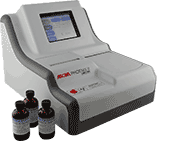- Home
- Tuotteet
- Prosessimittaukset
- Ametek
- XRF
- Ametek PHOENIX II XRF Analyzer
Ametek PHOENIX II XRF Analyzer
- General Details
- Specification
- Documents
- Application Notes
- Certificate
PHOENIX II XRF Analyzer
Features and Benefits
- 48kV X-ray tube
- Polarized X-rays using HOPG for measuring lighter elements
- One moveable secondary target for measuring heavier elements
- Rugged proportional counter detector with filters
- Onboard computer with touch-screen interface
- Windows™ operating system
- Networking capability
- Simple one-button analysis
- Low cost of ownership
Benchtop ED-XRF Analyzer
The PHOENIX II is a polarized Energy Dispersive-X-Ray Fluorescent (ED-XRF) benchtop analyzer that offers extreme simplicity of operation in a low-cost compact design. It is ideal for elemental analysis of liquids, solids, pastes, slurries and powders for measuring Al through U qualitatively and quantitatively. This ED-XRF spectrometer has been designed for use in the rugged environment of production process and quality control, but is also well suited for the laboratory. An onboard PC makes use of Windows™ operating system along with a simple, intuitive touch-screen display, making analysis easy for non-technical operators, but advanced enough for even the more experienced user as well.
The PHOENIX II combines polarized source X-rays, a movable secondary target and a rugged gas-filled proportional counter detection system, giving the PHOENIX II improved performance for the measurement of low atomic number elements such as Al and Si as well as S and Cl. The detector design yields a high X-ray count rate throughput and makes use of X-ray filters to separate the spectral peaks of elements with adjacent atomic numbers. With its onboard computer, no external computer is needed. The PHOENIX II does not require an external mouse or keyboard, yet offers USB, VGA and Ethernet connections for networking and connecting to external devices. This compact, simple to operate XRF system offers a unique combination of high powered polarized X-rays and a high sample throughput with rugged detector at a very affordable price and low cost of ownership.
| Own a Model 200T? Contact Suomi Analytics office near you to discuss the new PHOENIX II XRF as a replacement for the Model 200T. |
ASOMA Instruments was established in Austin, Texas, in 1979 as one of the first companies to offer low-cost benchtop ED-XRF instrumentation. Throughout the next decade and a half, ASOMA became established as an industry leader with the development and release of the Models 100, 200 and 200T-series, PHOENIX and Titan line of XRF analyzers, as well as instrumentation for measuring sulfur in hydrocarbon streams.
Typical Applications include:
- Ultra-Low Sulfur in fuels
- Sulfur and Chlorine in diesel, gasoline, crude oil, bunker fuel, other petroleum distillates
- Lead in gasoline
- Silicone coating on paper and film
- Conversion coatings
- Molybdenum in ores
- Chlorine in rubber
- Phosphorus, Sulfur, Calcium and Zinc in lube oil
- Many other applications possible
Technical Data
Excitation
- Polarized X-ray excitation
- HOPG Crystal (Highly Oriented Pyrolytic Graphite)
- One moveable secondary target
- End-window X-ray tube
- Max voltage 48 kV
- Max power 50 W
Detection Systems
- Rugged gas-filled proportional counter detector
- Automatic energy drift compensation
- Up to 5 moveable filters (optional)
- Low cost of ownership
Sample Chamber
- Single position (30mm cups)
- Bulk or flat samples (12 x 12 x 3 cm)
- Analysis of solids, liquids, powders, pastes, slurries, coatings, films, filter deposits
- Sample Spinner (optional)
Software/User Interface
- Touch-screen display
- Embedded Panel PC computer
- Password protection
- Windows™ operating system
- USB and Ethernet connections
- Networking capability
- External monitor connection
- Onboard thermal printer
Spectrometer Data
- Voltage: 115-220 VAC ±10% , 60W, 50/60Hz
- Dimensions: W x D x H: 38 x 46 x 31 cm (15 x 18 x 12”)
- Weight: 18 kg (40 lbs)
Product Data Sheets
Product Data Sheet
Application Notes
- Analysis of Lead and Sulfur in Fuel Oils Using Polarized Optics
- Analysis of Chrome on Steel Using Polarized Optics
- Analysis of Phosphorus & Bromine Flame Retardants in Fabric Using Polarized Optics
- Analysis of Silicone Coatings on Paper and Clay-Coated Paper Using Polarized Optics
- Analysis of Titanium in Nylon Sheets and Other Polymers Using Polarized Optics
- Analysis of Sulfur in ULSD (Ultra-Low Sulfur Diesel) Using Polarized Optics
- Analysis of Chlorine in Rubber and Windshield Wiper Blades Using Polarized Optics
- Analysis of Sulfur Content in Ethanol and Methanol Blends Using Polarized Optics
- Analysis of Phosphorous, Sulfur, Calcium, & Zinc in Lube Oil Using Polarized Optics
- Analysis of Phosphorous on Steel Using Polarized Optics
- Analysis of Sulfur in Crude and Fuel Oils Using Polarized Optics
- Analysis of Sulfur, Chlorine, & Calcium in Used Oils Using Polarized Optics
- Analysis of Conversion Coatings on Steel or Aluminum Using Polarized Optics
- Analysis of Zinc in Polystyrene Using Polarized Optics
- Analysis of Zinc Coating on Steel Using Polarized Optics
- Analysis of Titanium Dioxide & Zinc Oxide in Cosmetics Using Polarized Optics

